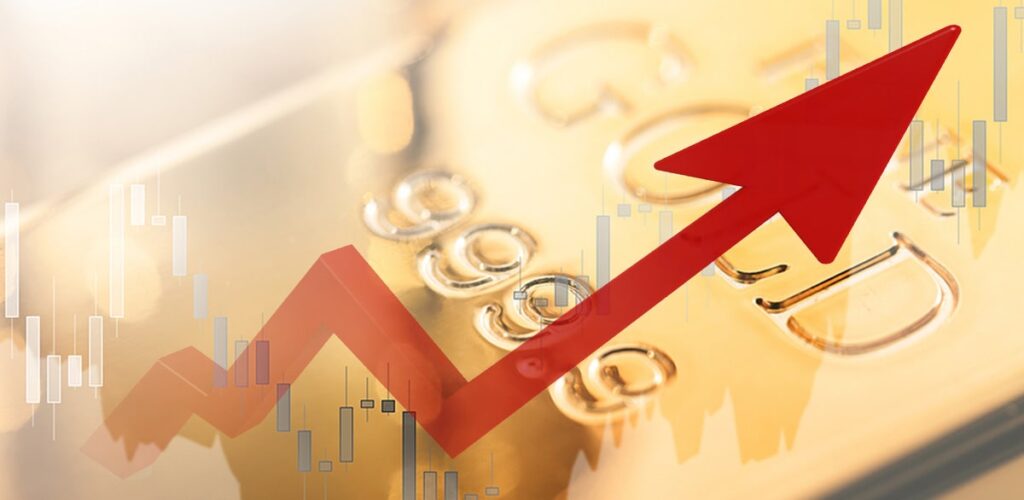Category: Silver

The economy seems to be stuck in a flashback as market, political, and geopolitical events continue mirroring those of 50 years ago. In the 70s, rampant inflation spurred stagflation, Israel was at war with its neighbors, and Russia was invading Afghanistan.
Since then, the ruling elite hasn’t just found a way to make zero improvements in decades, but they’ve even managed to make the situation worse. Watch this week’s The Gold Spot to hear Scottsdale Bullion & Coin Precious Metals Advisors Joe Elkjer and Damian White explain the ensuing bond shock, the monumental (and growing) US national debt, and how these economic pressures are impacting gold prices.
Surging Bond Yields Spark Selloff
The Federal Reserve’s aggressive interest rate policy has resulted in a dramatic surge in bond yields. For the first time in over 15 years, the 10-year Treasury yield is nearing 5%.
Rates are going up at a terminal velocity. We haven’t seen this kind of an increase [before].–
It’s important to note that bond rates are inversely proportional to investments. In other words, the value of an asset goes down as bond rates rise. This rapid jump in yields means bondholders are losing out quickly. Bank of America has already claimed unrealized losses of over $131 billion on securities.
This domestic bond shock is sending ripple effects across the global economy as foreign countries seek to safeguard against the increasing risk of US debt. China’s selling of US bonds just reached a four-year high as the CCP aims to strengthen its domestic currency.

Get more out of your gold & silver investments.
Learn how…
Unlock Free Report
An Unending Debt Crisis
As the bond crisis escalates, the US balance sheet continues accumulating unfathomable amounts of debt. Many people were hoping the $33 trillion US debt record would be a wake-up call for the Biden administration. Those hopes were dashed when debt rose by over half a trillion in a matter of weeks.
The interest on US debt almost doubled over the past two years to $659 billion on the back of laughable spending habits and irresponsible rate hikes. Forecasts place the United States gross federal debt at a staggering $51 trillion by 2033.1
With an entrenched war in Ukraine and a conflagration in the Middle East, many people expect spending to increase in the near future. Biden just served Congress with a $100 billion budget request for the conflicts followed up by a nearly $40 billion ask for childcare and disaster relief. Meanwhile, a fractious House is preventing any meaningful pushback from the other side.
Something is Going to Break
All fingers point to the Fed’s incompetent and reckless fiscal policies as the root cause of this economic catastrophe. It’s the same old story of unchecked spending leading to skyrocketing inflation which is ignored until an overzealous rate hike policy is demanded. No matter how resilient the US economy has been, it cannot outrun the ramifications of this failed strategy.
The system cannot handle this. Something is going to break.–
We’re already seeing cracks in the US economy forming under mounting pressure, and increasing bond yields only make the situation worse. Investors are seeing their spending power dwindle, and their investments shrink. A recent report revealed that mortgage payments on a new home are 52% higher2 than monthly rent.

Average Monthly Multifamily Rent vs. Average Monthly New Mortgage Payment3
It seems our fiscal czars are hellbent on inflating the economy out of debt, but their Modern Monetary Theory (MMT) experiment has failed thus far.
Related News: The US Can’t Grow Its Way Out Of Its $33 Trillion Debt Mountain, Research Group Says
Gold Decoupling from Bonds?
Gold prices have been notching higher increases and smaller pullbacks since the Israel-Hamas war began. The recent bond shock sent gold spot prices even further which is unusual considering precious metals tend to move in unison with the bond market. This uncharacteristic development suggests that gold might decouple from the bond market.
The last time that happened in the 1970s, gold experienced a massive price surge. Gold spot prices shot up from around $150 an ounce to over $800 an ounce. Everything is setting up for gold to make a similar move in the near future.
Gold could do something people haven’t seen in 50 years.–
Now is a perfect opportunity to dollar-cost average into gold before prices pop to $2,000 and beyond. Rich Dad, Poor Dad author Robert Kiyosaki recently repeated his advice for investors to accumulate gold instead of trying to time the market.
Gold dropped $10 today. Silver 14 cents. This is where “Dollar Cost Averaging” pays off. Rather than pretend to be Warren Buffet picking bottoms I am an average investor “accumulating” the asset I want for the long term. I have been accumating gold, silver, BC and real estate…
— Robert Kiyosaki (@theRealKiyosaki) October 23, 2023
If you’d like to learn more about investing in gold and silver, request your FREE COPY of our insightful Precious Metals Investment Guide. You can also get in touch with a personalized Precious Metals Advisor by calling toll-free at 1-888-812-9892 or using our live chat function.
Learn More About Dollar-Cost Averaging Gold

 Not long ago, the concept of a global digital currency was largely dismissed as the product of conspiratorial drama and dystopian fiction. Now, the International Monetary Fund (IMF) is explicitly calling for the development of a world digital currency. Investors can better protect their wealth and privacy from the worsening effects of monetary digitization by staying ahead of the trend of economic digitization.
Not long ago, the concept of a global digital currency was largely dismissed as the product of conspiratorial drama and dystopian fiction. Now, the International Monetary Fund (IMF) is explicitly calling for the development of a world digital currency. Investors can better protect their wealth and privacy from the worsening effects of monetary digitization by staying ahead of the trend of economic digitization.
What is a global CBDC?
A global central bank digital currency (CBDC) is a hypothetical worldwide digital banknote. It would be universally accepted and usable by consumers for domestic and international payments. In theory, this supranational currency could replace physical cash for everyday transactions. A global CBDC would be issued, regulated, and controlled by an international governing body such as the IMF, the Bank for International Settlements (BIS), or the World Bank.
Domestic vs. Global CBDC
The potential of a global CDBC raises questions about the currency’s relationship with domestic CBDCs. In reality, these digital developments are mirror images of each other only with differences in scope of use, issuing authority, and monetary system. For example, a potential United States CBDC would primarily be used within American borders, it would be issued by the Federal Reserve, and it would be beholden to the USD monetary system. Theoretically, domestic CBDCs would remain within the confines of each country while the global CBDC would regulate international transactions.
The IMF’s Role in the Development of a Global CBDC
As the head of the international monetary system, the IMF wields tremendous influence on the trajectory of macro and microeconomics. In fact, this international financial authority has the power to surveil domestic economies, determine which countries receive loans, and promulgate economic policies. Currently, over 190 countries are subject to the authority of the IMF, underscoring the group’s supremacy. Over the past few years, the IMF has been making concerted moves toward the development of a global CBDC. These efforts aren’t being hidden from the public, but they’re also not being covered by mainstream media.
“Centralization is what people should be worried about. The fact that a very small group of people can control everybody’s…access to the monetary system.”– Precious Metals Advisor Steve Rand
The Global CDBC Challenge
The IMF partnered with the Monetary Authority of Singapore (MAS), the city-state’s central bank, to host a worldwide contest for digital currency technology. The stated aim of the Global CBDC Challenge was to accelerate the development of technologies required to implement a CBDC on a large scale. Over 50 countries took part in the challenge with more than 300 individual proposals submitted. With a heavy focus on practical limitations and technological capabilities, this challenge underscores the IMF’s dedication to rolling out CBDCs across the globe.

Bracing for CBDC: Unmasking Key Risks Investors Should Prepare For.
Get Report – It’s Free!
The Digital Money Strategy
Just a month after the global CBDC challenge, the IMF put forth a Digital Money Strategy that mandated the group to “monitor, and advise on, digital money developments for all members” with specific attention paid to CBDCs. Furthermore, to meet the “challenges posed by CBDCs”, the IMF outlined its plans to expand resources and increase spending. Additionally, the strategy called for more cooperation with an international consortium of financial bigwigs including the World Bank, Bank for International Settlements (BIS), Committee on Payments and Market Infrastructures (CPMI), and Financial Stability Board (FSB).
CBDC Capacity Development
Recently, the IMF has been going much further than setting general policies or hosting contests in terms of global CBDC development. In April 2023, the world financial czar released a report highlighting its hands-on role in the research, development, and implementation of centralized digital currencies around the globe. In fact, the IMF is directly advising more than 40 of the over 100 countries pursuing a CBDC. More specifically, the report highlighted the IMF’s goal of influencing how central bank authorities think about CBDCs. This standardized approach to domestic digital currencies is a direct path toward a global CBDC.
IMF Calls for a Global CDBC
Most of the IMF’s involvement with a global CBDC could have fallen under the convenient categories of “hypothetical” or “experimental”. That was until the group’s Managing Director revealed that work was already underway to build an international CBDC framework. At a financial conference in Morocco, Kristalina Georgieva shared that the IMF was building towards “a global CBDC platform.” She stressed the importance of having an interoperable system that connects countries in an increasingly digitized currency system, warning that a lack of cooperation could encourage the use of cryptocurrencies.
Investing in the Time of a Global CBDC
As the preeminent leader in the global economy, the IMF’s attitude towards the digital economy can tell investors a lot about the future of digital currencies. In a revealing way, the IMF has fully embraced a global CBDC to the point of actively pursuing a fully centralized system.
Everyday investors might not have the influence to avert the IMF’s trajectory towards a global CBDC, but they can direct their investments accordingly. There’s a reason central banks are buying gold at record rates. Even the governments don’t trust these hyper centralized, supranational economic policies.
“Physical gold in your possession [is] the original decentralization. [It’s] the true way to get away from these digital currencies.”– Precious Metals Advisor Todd Graf
Smart money is following suit by diversifying their portfolios with gold. This shiny metal is a proven hedge against inflation that offers reliable price stability along with security and privacy.
The world economy is on a crash course toward a fully digitized money system with consolidated authority on the international stage. Staying up to date on key developments can keep investors in the best position to make savvy investment decisions. To help you keep track more easily, we’ve created a FREE CBDC Exposure Report. Request your FREE COPY here!

 Over the past few years, we’ve highlighted the steady increase in gold demand to our readers. It’s unsurprising when the demand for gold ebbs and flows as with any other asset, but we’re in the midst of a veritable modern-day gold rush. Everyone from retail and institutional investors to central banks is scooping up more gold in anticipation of worsening economic conditions. Smart money is paying attention to this rising gold demand and taking cues from the biggest players in the game.
Over the past few years, we’ve highlighted the steady increase in gold demand to our readers. It’s unsurprising when the demand for gold ebbs and flows as with any other asset, but we’re in the midst of a veritable modern-day gold rush. Everyone from retail and institutional investors to central banks is scooping up more gold in anticipation of worsening economic conditions. Smart money is paying attention to this rising gold demand and taking cues from the biggest players in the game.
Demand for Gold in Numbers
Simply saying gold demand is at all-time highs doesn’t give investors much to work with. Fortunately, there are several metrics that demonstrate exactly where we stand in the landscape of precious metals investing.
Central bank gold demand skyrockets.
Central bank gold demand reached a 55-year high in 2022 with a whopping 1,136 tons added to reserves across the globe. This represents an 18% jump with total holdings reaching 4,741 tons by year’s end. The record-breaking fourth-quarter binge of 1,337 tons could have been the closing exclamation point on annual demand, but the beginning of 2023 proved it to further the trend. The demand for gold surged even higher with quarter-one purchases setting a first-half record with 387 tons. It’s worth noting that the lion’s share of these gold purchases went unreported which means many nations prefer to keep their reserves a mystery.
“The bigger central banks…and nations…are buying a ton of gold. Take a page out of their book.”– Founder Eric Sepanek
Emerging markets dominate gold purchases.
The US might still hold the largest gold reserves in the world, but the vast majority of recent central bank gold demand is concentrated in emerging markets. Burgeoning economies such as China, Russia, India, and Turkey have dominated gold buying since the 2010s. In fact, these countries accounted for 65% of total gold demand between 1999 and 2021, according to the International Monetary Fund. China has been at the head of the pack as of late with nine consecutive months of gold buying going into mid-2023. In total, the PBOC’s reserves have jumped by 103 tons, accounting for 4% of global supply.
Gold’s price performance strengthens.
Gold prices have a positive correlation with gold demand. In other words, prices tend to jump higher as purchases increase. This can have a positive feedback loop as investors become eager to lock in a lower cost basis before gold’s value increases. As a result, recent gold price performance can shed light on how demand might look in the future. The average gold price in 2003 was $363.83/oz. Today, gold hovers around $1,900/oz. That represents more than 421% of growth within the past three decades alone. Experts anticipate this exponential growth to continue in the future as demand for gold steadily increases.

Learn everything you should know about investing in precious metals.
Request the Free Guide
Gold buying outpaces selling.
Central banks consistently buy and sell gold depending on domestic demands, market behavior, economic pressure, and various other factors. As a result, real insights lie in the net trends. In other words, investors should be asking themselves whether central banks are buying or selling more gold overall. Once again, the numbers are clear: Gold demand is outpacing gold sales by a significant margin. From January 2022 to May 2023, only three months saw net sales from central banks. This trend is indicative of a larger transition from net gold selling in the 1990s and 2000s to a period of booming central bank gold demand that’s still ramping up.
What Investors Can Learn From Booming Gold Demand
Gold is a reliable store of value.
Governments might be running a fiat-based economy on the surface, but they’ve never stopped stockpiling gold. That’s because gold is one of the most reliable stores of value. Since the 1930s, the dollar has depreciated by 99% when compared to gold’s value. Unironically, that’s precisely when the US abandoned the gold standard. Gold demand remains high because governments know the fiat-based economy isn’t stable.
The worst is yet to come.
Central bank gold demand tends to peak during times of peak economic uncertainty. As a reliable hedge against inflation, gold is the asset of choice when mainstream markets buckle. Lately, central banks have been stockpiling gold at record rates which demonstrates the lack of faith our financial czars have in the global economy. No matter what they might try to get us to believe, these leaders aren’t confident in the future.
The dollar’s dominance is over.
Another crucial lesson investors can learn from increased central bank gold demand is the reality of the dollar’s decline. Despite being the sole world reserve currency, the greenback no longer offers the protection, security, and stability foreign countries seek. This is leading to a seismic shift in the global economy as countries pursue de-dollarization to limit their dependence on USD.
Gold prices are headed higher.
The sharp rise in central bank gold demand is expected to place significant upward pressure on gold value in the not-so-distant future. The gold price forecasts for 2023 look extremely healthy with some experts even predicting a $4,000/oz price point. While it’s impossible to guess precisely where prices will land, it’s safe to assume the steadily increasing demand for gold will drive gold values higher.
Translating Gold Demand Into a Personal Investment Strategy
The average person can gain valuable insights by watching the moves of institutional investors, but this knowledge isn’t inclusive of personal risk tolerance, budget limitations, and long-term goals. That’s why working with a reputable and experienced precious metals advisor is crucial when investing in gold. These experts can help you determine the most effective and efficient investment strategy based on your unique needs and objectives. Get in touch with one of our precious metals advisors by calling toll-free at 1-888-812-9892 or by using our live chat function.
Outcrop Silver
Wed, 10/25/2023 – 09:44
Outcrop Silver
Wed, 10/25/2023 – 09:44
